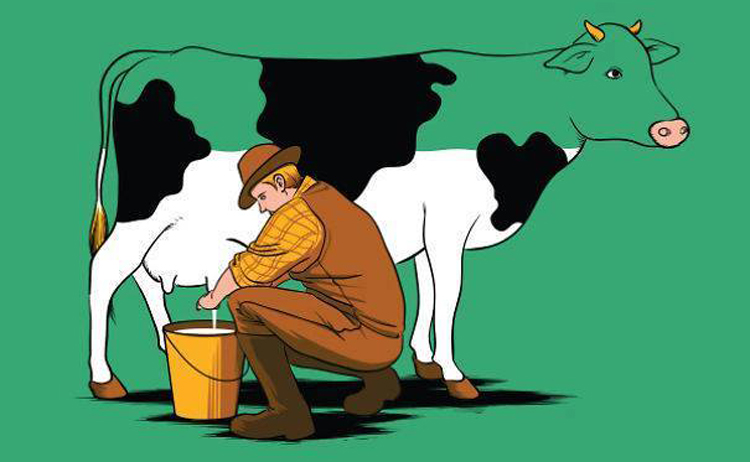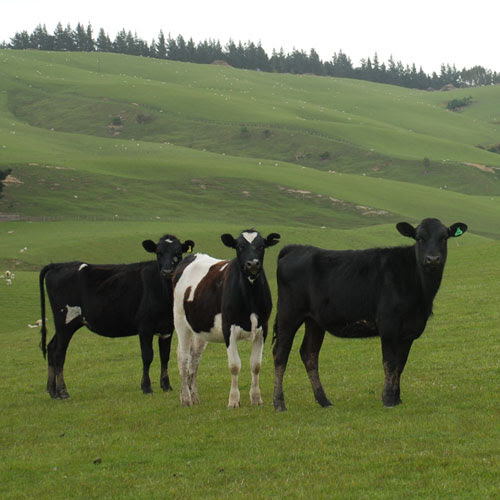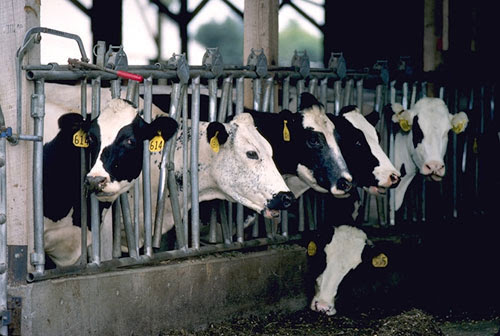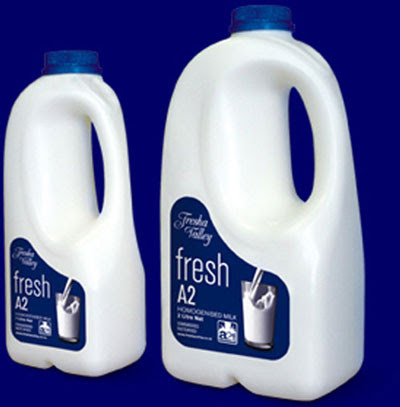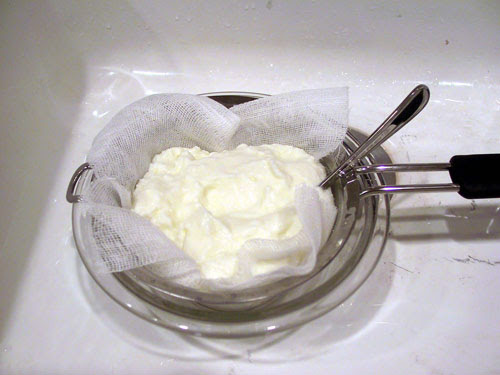To drink milk, or not to drink milk, is a question that isn’t easily answered. There are a lot of conflicting theories about dairy products, depending on where you’re looking for your information. Dairy producers will tell you that milk is good for you. They’ll also tell you about all the good things they’ve done to it to make it better – like pasteurising it (so you don’t get food poisoning), homogenising it (so it’s creamy all the way through), taking the fat out (so it’s not creamy at all, to save you from getting fat) and adding extra calcium (for prevention of osteoporosis). They may not tell you that by pasteurising it, they have destroyed the enzyme that enables you to absorb calcium, so all that calcium is useless. Anti-milk sites will tell you milk is food for baby cows, but is toxic poison for people. They may not talk about areas of poverty where having a cow and being able to rely on fresh, clean milk means the difference between life and death. Others will tell you that raw or cultured milk is good, but pasteurised or homogenised is bad. They may not always be aware that some people are so ill suited to drinking milk, that even the best quality raw milk must be avoided.
As you can see, the truth is a little more complicated. Let’s look at all aspects of the question, so you can make the best choice for you. There are two main things you need to take into account – the quality of the milk, and your individual tolerance to it. What are the characteristics of good quality milk?There are various aspects to take into account: Type of feed Organic vs. non-organic A1 vs A2 milk Type of cows Fat content Homogenised or not Raw vs. pasteurised Freshness Type of feedThe quality of the milk depends on the quality of the feed. It is vital for cows to be raised on pasture, eating grass or hay, with room to roam about, and somewhere clean to rest and sleep. NZ readers are probably wondering why that needs to be spelt out, as that is how all cows are raised in New Zealand. But that’s not the case in all countries. In the US, for example, many cows are kept in confinement, unable to find a clean place to stand or lie down, never see the sky or breathe fresh air, and eat grains (or worse, according to Fast Food Nation, by Eric Schlosser) Cows are designed to eat grass and are not meant to be fed on grain. Products from cows fed grass contain much higher levels of CLA (conjugated linoleic acid – a fat with cancer fighting properties), Omega-3 fats, beta-carotene, vitamin A, and vitamin E than those those fed grains. For more details, see www.eatwild.com As well as feeding cows inappropriately, factory farming methods may include: confining the animals in spaces too small for them, feeding of growth hormones such as rBGH (made by Monsanto), which causes mastitis, a painful udder infection, routine feeding of antibiotics to prevent illness.
The Meatrix video shows this more graphically than I can, so check it out here. (But remember to come back here for the rest of the article. Factory farming is the just the beginning of the milk story.) For decades, vegetarians and vegans have been shunning meat and/or dairy products for animal cruelty reasons. But to do that may be sacrificing your health unnecessarily. Now also online is The Meatrix II which begins to highlight some of the alternatives, such as supporting small, local farms, eating free range eggs and pasture raised dairy. [In NZ, cows and sheep are generally pasture raised, but pigs and chickens are often confined. So it’s important for many reasons to buy free range eggs and organic, free range chicken and pork.] Organic vs. non organicPesticides on grass that is eaten by cows make their way into the milk supply. A healthy person’s liver can neutralise and eliminate such toxins. But we’re exposed to lots of toxins in our modern world. At some point your liver will get overloaded and be unable to do it’s job properly. So it makes sense to eat organic when you can (without stressing about it if you can’t). This applies to all foods, not just dairy. Pesticides are usually herbicides (about 65% in NZ), fungicides (20%) or insecticides (10%). In NZ, some of the residues that may be in non-organic milk include DDT and organophosphates. DDT has been used in NZ since the 1950s. It was banned in the US in 1972, but not until 1987 in Australia and 1989 in New Zealand. It was used in livestock farming here till the end of the 70’s and even longer in orchards and home gardens. DDT remains in the soil for long periods of time, and residues are still being found in milk and other products today, with Canterbury being particularly affected. There is a level of DDT that is considered “safe” and milk can be sold containing up to that level. Consider that commercial milk comes from a variety of sources, and while some are low in DDT, some could be quite high. When the milk is all mixed together, the average level is below the cut-off point. But what would be the ethics of selling milk known to be high in DDT, by combining it with safer milk, if such a thing is happening? In 2000, the Safe Food campaign found that NZ children were exposed to five times the pesticide residues that US children were. This is mostly from organophosphates and fungicides. Although the Ministry of Health felt that this was not a problem, the Safe Food campaign felt it was a major health issue and so do I! A1 vs A2 milkAnother aspect of the milk is whether the beta-casein component of the protein is A1 type or A2 type. Although it’s not conclusive at this stage, research done at Lincoln University, in New Zealand, has shown correlations between A1 milk and diseases such as heart disease and Type 1 diabetes. These diseases have no such correlations with A2 milk. Originally, all milk was A2. About 5000 years ago there was a mutation in Europe and the A1 genes spread through cow herds. These days: Goats and sheep milk is equivalent to A2 milk, as is human milk. Heirloom breeds tend to have more A2, newer breeds – A1. Different countries have a different mix between the two. For example, Iceland is mainly A2, where Finland is more A1. the level of heart disease is higher in Finland. Masai and other African cattle only produce A2 milk, which is significant when you consider that the Masai are very healthy on a diet of mainly meat, blood and fermented milk, with little heart disease. There is some A2 milk and cream available in New Zealand, try your organic store. Type of cowsHolstein or Friesian cows are commonly used for producing dairy as they have a higher milk yield. But more isn’t necessarily better. To achieve this, they are bred to have higher levels of growth hormone, which is undesirable for feeding to children, unless they have growth deficiency diseases. I prefer milk from Jersey or Guernsey cows – which has these characteristics: It is usually predominantly A2 milk Lower production of milk per cow, which means the available vitamins are more concentrated in the milk A higher quantity of cream, so rich in the fat soluble factors Generally seems to have a superior taste Which leads to your next question – but surely more cream and thus more saturated fat is bad for me? The fat contentMany people are now purchasing low fat dairy products under the mistaken belief that saturated fats, especially dairy fats, are bad for you. In fact, traditional societies ate large amounts of saturated fat and enjoyed excellent health. When they started eating “western” food, their health declined dramatically. Animal fat is a good source of valuable vitamins such as A & D, which are needed to assimilate calcium and protein. Many people believe that betacarotene, found in plants, is the same as Vitamin A. Beta-carotene can be converted to Vitamin A by most people, but some people are unable to make the conversion or make it poorly, especially infants & children (those who need it most) and people with hypothyroid or diabetes. Fat is also needed to make the conversion, so conversion can also be hindered by a low fat diet. Fat, and vitamin A, are needed for the proper utilisation of protein. Problems with too much protein are usually because lean protein is being eaten, without the needed fat. Tribes studied by Weston Price, when on their native diets, knew to avoid lean meat, as it made them ill, and would eventually kill them. It is widely and inaccurately repeated that eating fat makes you obese. Certainly some fats are very unhealthy, but saturated fats and cholesterol are needed by the body for building materials. It is mainly excess carbohydrates (eg bread, pasta, sugar) that get stored as fat. The main increase in heart disease has been since we started adopting low fat diets. Many studies have shown that those people who eat most saturated fats have the least heart disease. We are just starting to learn about the role of certain fatty acids (such as CLA – conjugated linoleic acid) and how they are vital to our well being. For example, CLA isomer 9-11 (the isomer found in milk) is being linked to and credited for its ability to fight and prevent cancer cell growth. Our bodies cannot make these fatty acids. CLA is only produced in ruminant animals and is only available in any significant quantity in 100% grass fed ruminates. In Nutrition & Physical Degeneration, Weston Price talks about the health benefits of butter. In his studies, he found a substance he called Activator X. At first he thought it was Vitamin D, but found it had some different properties. It is especially important in mineral utilisation, including building tooth strength. The best source of it is butter from cows that are consuming the fast growing spring grass. HomogenisationHomogenisation is a process that breaks down butterfat globules so they don’t rise to the top of the milk. But by doing so the structure of the fat is changed. There is a big increase in surface area of the fat globules. The original fat globule membrane is lost and a new one is formed that incorporates a much greater portion of casein and whey proteins. Lipid scientist Mary Enig thinks this may be one of the reasons modern processed milk is a common allergen. Other researchers have hypothesised that these changes may account for the increases in heart disease, but that hasn’t been proven. At this stage, we just don’t know how damaging the homogenization process is, and can’t be sure it’s benign. So whether you choose raw or pasteurized milk, avoiding homogenised milk is probably prudent. Raw or Pasteurised?We’re told that milk has to be pasteurised to kill pathogens and prevent disease. The practice of heating milk to kill germs was instituted in the 1920s to combat diseases caused by poor animal nutrition and dirty production methods. But times have changed and modern production methods make pasteurisation unnecessary for public protection. Pasteurising kills harmful bacteria, but also destroys enzymes (including the one needed for utilising calcium), diminishes vitamin content, denatures fragile milk proteins, destroys vitamin B12, and vitamin B6, kills beneficial bacteria and promotes pathogens. It is also associated with allergies, diabetes, increased tooth decay, colic in infants, growth problems in children, osteoporosis, arthritis, heart disease and cancer. You may have heard stories of people getting sick from raw milk, due to pathogens such as campylobacter, salmonella, e.coli and listeria. It can happen, but is very rare in good quality, organic, grass fed, raw milk. That is due to the natural disease-fighting enzymes present in raw milk from healthy animals, some of which specifically target salmonella and listeria, for example. In California, one organic farm who produce raw, grass fed milk, deliberately contaminated a batch of their milk (for testing purposes only!) with millions of pathogens. Within a few days, they had nearly all been neutralised. If pasteurised milk is exposed to pathogens, on the other hand, it is far more dangerous, as there is nothing to combat them. Nearly all cases of food poisoning are from eating foods other than raw milk (generally foods that most people eat with no concern), or from contact with non-food contaminants. Often an illness is initially attributed to raw milk, but is then traced to something else. There is a small danger that people with very compromised immune systems may occasionally contract a disease. But this is a much smaller risk than that of developing a chronic illness due to the consumption of pasteurized milk. And to offset it further, raw milk has potential to build up the immune system of such people. A byproduct of killing bacteria by pasteurisation is the formation of histamines. This may be one reason that so many people have asthma or allergies from drinking milk. Raw milk doesn’t contain histamines, and many asthmatics find that while drinking it regularly, they have no or few asthma attacks. Historically, raw milk was successfully used as a treatment for many illnesses, including chronic diseases such as asthma. Calves fed pasteurised milk do poorly and many die before maturity. Similar effects have been observed with other animals. Early last century, a scientist called Pottenger conducted a series of feeding experiments on cats, over a 7 year period. Those he fed on raw meat and raw milk thrived. Those fed cooked meat or pasteurised milk quickly developed many diseases, by the 2nd generation had stunted growth and high kitten mortality rates, and by the 3rd were unable to reproduce. Possible health benefits of switching from pasteurised to raw milk include:
If you want to read more about raw milk, go to: www.realmilk.com or get hold of The Untold Story of Milk by Ron Schmid. FreshnessOne reason that the big milk producers want to pasteurise the milk is that it will keep longer. With raw milk, after a few days it will sour naturally. It is still nutritious, but turns to a different form. So with raw milk, you can always tell how fresh it is. Pasteurised milk may already be several days old by the time it reaches the supermarket. There is no way for you to tell how fresh it is. You can tell when it’s gone off though – it turns putrid and undrinkable! Summary of what to look forIf you’re just looking at the quality of the milk, the best milk to buy is generally: Grass fed Non-homogenised Raw Organic A2 milk, or from Jersey cows, goats or sheep If you can’t get all of these, make sure it is at least pasture raised, non-homogenised and full cream; and organic, if possible.
There is a way to restore some quality to milk that isn’t as good as you would like, and that’s by culturing (fermenting). Culturing creates beneficial bacteria and yeasts which help maintain digestive health. So even if you feel great on milk, consider trying some ferments for additional health benefits. Traditionally, most cultures who ate dairy products ate them in fermented form, as one of those below or as cheese. The cultured dairy you’re probably most familiar with is yoghurt (or yogurt). But I’m not talking about the type of yoghurt that has sugar, flavourings and skim milk powder added. I’m talking about natural yoghurt, preferably full fat, with live cultures, and no additives, made from the milk of grass fed cows. In NZ, a couple of examples are Bio Farm Organic Acidophilus and Cyclops European style (with the green lid). The beneficial bacteria in yoghurt typically include Lactobacillus acidophilus and bifidus. You have maybe heard that yoghurt with these live bacteria, or a supplement containing them, is good for replenishing the good bacteria in your gut after taking antibiotics. You can also make your own yoghurt, using a good quality bought yoghurt as a starter, or part of a previous batch. Another very popular type of fermented milk is kefir. It is generally thinner in consistency than yoghurt, a bit tangier, and yeastier in flavour. It is easier than yoghurt to make at home, but you do need starter “grains”. The good news is that once you have your kefir grains, they grow with each batch you make. So after a while you have enough to share with friends. This means you can usually get hold of some free, or just for the cost of postage. If you’re in NZ, email me for a contact near you. If you’re overseas, check out the Rejoice in Life website. Click here to download instructions for making your own kefir. Kefir is believed to come from the Northern Caucasus Mountains, and has been used in what was formerly the USSR, and surrounding areas, for 3 centuries. A website with loads of information on kefir is Dom’s “kefir in-site”. His site has a full list of the beneficial compounds typically found in kefir – Lactobacillus acidophilus plus many others. You
may also see mail order kefir kits for making kefir from a powdered
starter. The product you make from this starter is just as beneficial,
but doesn’t reproduce. So if you can get them, grains are a better bet
in the long term. Also available is Caspian Sea yoghurt or viili. It’s even easier to make at home – you just mix part of the last batch with your milk (about 10% starter), mix well, cover with something that will let in the air and leave on the bench for 12-24 hours. It is thicker and “gloopier” than either yoghurt or kefir with a mild flavour. The beneficial bacteria are Lactococcus lactis subsp. cremoris FC and Acetobacter orientaris FA, working together. Viili originated in the Caspian Sea (so in the same area as kefir), and was taken to Japan by a scientist working there who observed how good it was for digestive health. It has been used widely in Japan since then. If you’re in NZ, email me for a contact near you.
Is milk a suitable food for humans?When thinking about whether a food might be suitable for humans, a good rule of thumb is often to ask “Would (or could) my ancestors have eaten this?” Our ancestors originally ate what they could hunt or gather – wild game, berries and fruit, greens and vegetables, nuts and seeds. Later when they were able to domesticate animals, dairy products and eggs were added. Grains and legumes weren’t commonly eaten till humans settled in one place, instead of being nomadic, and were able to regularly grow crops. Goats and sheep were domesticated around 9000 BC, and cows around 7000 BC. So not a huge amount of time, in evolutionary terms. Some of us have adapted to thrive on dairy, and some don’t do well even on the best milk around. We’ve already talked about the drawbacks of bad quality milk, now let’s look at possible drawbacks of good quality milk. The main problem is that nature designed milk as a food for baby cows: Calves have very different digestive systems to either baby or adult humans. The milk protein is different from the protein in human milk, as is the type of fat. Goat and sheep milk are much closer to human milk in composition than cows milk. And remember that no other species continues to drink milk beyond infancy. There are two problems caused by this. One is that we don’t have the right digestive system to digest cows milk. So many people are unable to properly digest dairy products, and undigested food leads to a variety of health issues. This is one of the reasons for so many dairy allergies and intolerances. (Another, of course, is the appalling quality of most commercial milk, as discussed earlier.) The other is that even if we are able to digest it, it is a high calorie food designed for fattening up growing juveniles. So in practical terms, often people may feel really good on good quality raw milk, but may find that that they put on weight. So the milk is nourishing them – too well! But we are evolving organisms, and SOME people, through need or longer hereditary exposure have learned to be nourished by milk. There is too much evidence of people regaining their health after drinking good quality raw milk to discount the possibility. People who do well on milk could include: Some people have ancestors who relied on milk for their protein and fat source, such as those from India or the Swiss Alps. These people are likely to actually need milk products. Some people from the Middle East would have ancestors who drank goat or sheep milk, and would do well on goat milk, but maybe not so well on cow’s milk. Some people can quite happily drink any kind of milk with no apparent ill effects, but don’t really need it. Others who may not necessarily be as well suited genetically, but who may need the nutrients due to lifestyle choice or circumstance, could be those who are unable to get adequate protein, animal fat and fat soluble vitamins from their diets: Vegetarians, especially those who don’t eat fish. As well as protein and fat soluble vitamins, animal products are the only source of Vitamin B12. People with limited financial resources may not be able to afford meat regularly. Dairy products and eggs will help supply the necessary nutrients. Adelle Davis, in her classic book from the 60’s Let’s have Healthy Children, recommends raw or cultured, full cream milk for all children. This would especially apply to those infants who are unable to be breastfed, or children who are undernourished due to poverty. For those who can’t tolerate cows milk, she recommends yoghurt or goat milk. In many third world countries, dairy products are vital for survival. An anecdote – When the US was first settled, it was a very hard life, and many people had to return to England, as they couldn’t support themselves on the land. It wasn’t until they were able to keep cows and drink the milk, that enough people were able to stay and remain in health.
There are probably not many people who actually NEED dairy, but as with grains, most of us have come to like and want it. It can be a very convenient food, but isn’t always necessary. So we need to weigh up our habits and wants against our body’s need, consider the pros and cons and make our own decisions. Only you can figure out whether dairy products are beneficial, neutral or harmful for you, and make your choices accordingly. After all, all manner of rubbish that we never evolved to eat is sold under the guise of food in every supermarket. Individual levels of toleranceIf you don’t do well on milk, let’s look at the possible reasons. The first to consider is that your problem is with processed milk. This could be for several of the reasons discussed above under pasteurisation – like not enough enzymes, or production of histamines. So check that out first. Get hold of some good quality, raw, grass fed milk and try it out. For many people, that is the only change you need to make. Once the issue of quality has been addressed, there is no longer a problem. Or even better, get your good quality milk and culture it, and see how that is for you. But if that doesn’t help, and you really do have a problem, there are several possible reasons, which can be broadly broken down into 3 categories: An allergy to some component of dairy, eg. :
An inability to digest some part of the dairy, eg:
Just being generally unsuited to milk metabolically
Dairy allergiesWe’re talking here about true allergies, where there is an Ig reaction of some kind. (See the gluten intolerance page for more details about the differences). The most common is to casein, which is in all forms of dairy, and is unaffected by fermenting. Some people are affected specifically by the A1 casein, and can tolerate A2. But otherwise, your dairy choices are restricted to possibly butter or ghee. If it’s the whey you’re reactive to, you may be able to tolerate cheese. Some people react to phenolics (chemical compounds in dairy) . As far as I’ve been able to find out, phenolics are not a problem if the milk is raw. Lactose intoleranceThis is not actually an allergy. Instead it is an inability to produce the enzyme lactase, which is needed to digest lactose. People who can’t digest lactose can sometimes drink:
Or you can supplement with a capsule of lactase enzyme each time you eat dairy products. Inability to digest complex carbohydrates Breaking the Vicious Cycle, a book by Elaine Gottschall, explains why some people are unable to digest complex carbohydrates, and outlines a diet (the Specific Carbohydrate Diet) that excludes the offending carbs. People with a wide range of complaints including colitis, Crohn’s disease and autism have had success with this diet. If you’re gluten and dairy intolerant, and still having problems once those foods are excluded, it may be worth trying the SCD for a while. Inability to digest fatsThere are several possible reasons for being unable to digest fats:
Not suited metabolicallyWe all have different metabolic needs. The various types of metabolic typing have different recommendations on dairy. For example: If you just don’t feel as good as you could, on dairy, and can’t track down any specific intolerance, keep it to a minimum. But still use butter or ghee, as they are easily digested fats for most people. What to do if you can’t have dairy at allBack in Hunter Gatherer times, our ancestors didn’t eat dairy products or grains. But we’ve got used to them being such a huge part of our modern diet that we don’t know what to do without them. On other pages, I’ve talked about gluten intolerance and what to do about it. For some people, it’s easier to give up wheat & gluten, than it is to give up dairy. “The Garden of Eating” by Rachel Albert-Matesz and Don Matesz is an excellent cookbook full of delicious recipes for a Hunter Gatherer diet. It’s high in fruits and vegetables, nuts and seeds, meat and fish, and without grains or dairy, and is a useful resource. Rachel has written a fabulous dairy-free, gluten-free book called “The Ice Dream Cookbook” full of ice cream recipes made with coconut milk. There are over 40 ice cream flavours to choose from, a dozen sauces and other dessert extras that are all gluten free. There are a few baked goods that use sorghum flour, which is not easy to find in NZ, but most other ingredients are available here. (Sorghum flour is also known as jowar flour, and may be available in some Indian shops). For those of you concerned about getting enough calcium, check out my calcium page to see other foods that you can get it from. In the meantime, here’s some ideas for substitutions. Milk
ButterButter
is the most necessary of the dairy products, as it is in the fat that
all the most beneficial nutrients are found. Some people who have
trouble with other dairy products can eat butter with no ill effects. So
try that first. You may even like to try making your own, from good
quality raw cream. Here’s how to make butter. If that’s no go, next is to try ghee, also called clarified butter. Homemade is best as you can control the quality yourself, and it’s fairly easy to make. Here’s how to make ghee. In some places, you can also buy butter oil, which is similar. All of the critical nutrients are concentrated in the butter oil or ghee. Butter oil is more concentrated, and hasn’t been heated, so also contains Wulzen factor, also known as anti-stiffness factor. If even ghee causes a reaction, you still have some options, depending on what need you want to fulfill.
Ice creamIf you feel good on the coconut milk, try coconut ice cream. It’s a bit icier than dairy ice cream, but still delicious. Click on this link and scroll down for an ice cream recipe from Bruce Fife’s “Coconut Lovers Cookbook” and some other coconut recipes. If you don’t need to be on a carb controlled diet, fruit sorbets can hit the spot on a hot day. Or for a quick sorbet, zizz together in the food processor: a chopped frozen banana, some coconut oil, some vanilla essence, a pinch of sea salt, and some natural sweetener such as honey or maple syrup. Eat straight away. You can also add extras such as cocoa, carob or pecans for different flavours. CheeseThis is probably the trickiest and nothing really works. The best suggestions that the people on the GFCFNN board can come up with are: Corn polenta, maybe with chopped up sausage and herbs, Lardo – which is made by burying lard or other animal fat in salt Whatever you do, though, avoid soy cheese, for all the usual reasons soy is undesirable. Summary of recommendationsDo your own analysis of the benefits and drawbacks of dairy products, as only you know your own level of tolerance and need. But as a rough rule of thumb, here’s what I’d suggest: Avoid processed milk if you possibly can If you’re currently using it and feel fine:
If you’re currently using it and think it may be causing problems:
If you’re not using dairy as you react badly to processed dairy:
If you’re not able to tolerate any dairy at all, look for other ways to get the nutrients recommended by Weston Price.
|
SIFT TOP 5 MOST POPULAR BLOG POSTS THIS WEEK - Scroll down to see the latest posts
-
GO WOKE, GO BROKE... Volkswagon's virtue signaling diversion into electric vehicles In the late 2010s, VW began its push into electric...
-
Calling this my 10th Anniversary post is not 100% accurate because I've been posting stuff online since October 1998 in various fo...
-
At some point in the past few years, the penny dropped and I realised Apple, Microsoft, and later, Google, were all set up by the deep stat...
-
A long standing tradition, that I've been doing since the dawn of time, is to do a blog post on the first day of each new year, usually ...
-
“I t is my heart-warmed and world-embracing Christmas hope and aspiration that all of us, the high, the low, the rich, the poor, the adm...
REAL MILK
Subscribe to:
Comments (Atom)




.png)
